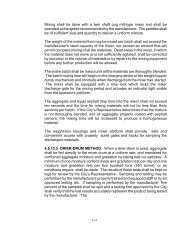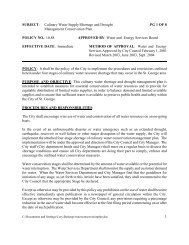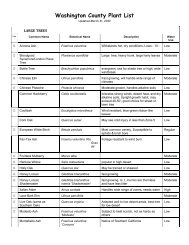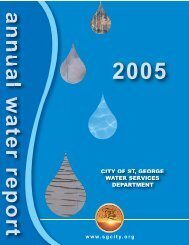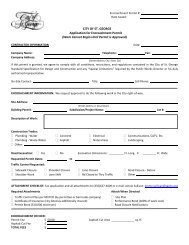You also want an ePaper? Increase the reach of your titles
YUMPU automatically turns print PDFs into web optimized ePapers that Google loves.
from the Middle Jurassic <strong>of</strong> England. The British cones are about the<br />
same size as the ones described here, have a similar wedge-shape, and<br />
bear a single broad seed (Cleal and Rees, 2003). The poorly preserved<br />
cone scale complexes described from Scotland as A. millerii Seward (1911)<br />
resemble somewhat those considered here except that the seeds are relatively<br />
narrow compared to the seeds <strong>of</strong> the new species. In the Southern<br />
Hemisphere, similar cone scales have been illustrated by <strong>St</strong>ockey (1994)<br />
from the Jurassic <strong>of</strong> New South Wales, Australia.<br />
Triassic Araucaria-like cone scales are much less common than<br />
Jurassic forms. Probably the best documented such fossils are the conescale<br />
complexes assigned to Araucarites charcotii Harris (1935) from the<br />
latest Triassic (Rhaetic) <strong>of</strong> East Greenland. Although they are nearly the<br />
same age, they differ significantly from the specimens described here.<br />
First, the fossils from Greenland are more or less diamond-shaped with<br />
long, tapered distal halves that are delicate, wedge-shaped, and sturdy<br />
with a short apical beak on the rounded apical margin in the present<br />
material. Also, the ovules in the Greenland specimens dropped before<br />
the cone scales were preserved, in contrast to A. stockeyi where most<br />
ovules are retained. Furthermore, the ovules are much larger (5-8 mm<br />
wide) in the new species than those in the Greenland specimens. The<br />
latter were probably only about 4-5 mm wide since the shallow depression<br />
in which they were located is the width <strong>of</strong> several <strong>of</strong> the cone scales.<br />
The two incomplete cones here tentatively assigned to this species (see<br />
Figs. 3J, K) resemble slightly the cone described as Aliostrobus traversei<br />
Ash (1999) from the Upper Triassic <strong>of</strong> east-central New Mexico. The<br />
plications found in the cone scales in the cones from both localities are<br />
particularly noteworthy.<br />
Discussion: It appears that the seeds <strong>of</strong> Araucarites stockeyi<br />
were <strong>of</strong>ten retained on the scale complexes at shedding as in section<br />
Eutacta. The absence <strong>of</strong> ovules in the cones and their small size maybe<br />
an indication that these two fossils are immature compared to the dispersed<br />
forms. The falling away <strong>of</strong> the seed in one specimen <strong>of</strong> the new<br />
species (Figs. 3C, D) has also been reported by <strong>St</strong>ockey (1975) in Araucaria<br />
mirabilis (Spegazzini) Calder (1953) from the Jurassic <strong>of</strong> Argentina.<br />
The presence <strong>of</strong> what most certainly are araucarian cone-scale<br />
complexes at the SGDS in the very Early Jurassic indicates that the<br />
origins <strong>of</strong> the family must lie earlier in time, such as in the Late Triassic.<br />
Interestingly, however, such fossils have not yet been identified with<br />
certainty in the underlying Chinle Formation <strong>of</strong> Late Triassic age that is<br />
widely distributed in the southwestern United <strong>St</strong>ates. However, the<br />
majority <strong>of</strong> plant fossils that are known in the Chinle occur in the lower<br />
part that is assigned to the Late Carnian/Early Norian. Thus it may be<br />
that the earliest araucarians lie in the slightly younger (Late Norian/<br />
Rhaetic) parts <strong>of</strong> the Chinle and equivalent strata in the Southwest and<br />
elsewhere.<br />
Family Uncertain<br />
Genus Saintgeorgeia new genus<br />
Type species: Saintgeorgeia jensenii n. sp.<br />
Derivation <strong>of</strong> name: After the city <strong>of</strong> Saint <strong>George</strong> where the <strong>St</strong>.<br />
<strong>George</strong> Dinosaur Discovery Site at Johnson Farm is located.<br />
Diagnosis: Leafy shoot forming flattened spray, ultimate branches<br />
in a single plane, leaves scale-like, opposite on penultimate branches,<br />
spirally arranged on ultimate branches. <strong>St</strong>aminate cones attached to ends<br />
<strong>of</strong> ultimate branches.<br />
Geologic range: Early Jurassic in southwestern Utah.<br />
Saintgeorgeia jensenii new species<br />
Figures 4A-G, 5B, C<br />
Holotype: SGDS.627A, B.<br />
Paratypes: SGDS.517A.<br />
Derivation <strong>of</strong> name: From the name <strong>of</strong> the present owner <strong>of</strong> the<br />
type locality, Paul Jensen.<br />
417<br />
Diagnosis: Leafy shoot, forming more or less flat sprays,<br />
penultimate branches straight, 3-5 mm wide, more than 17 cm long,<br />
ultimate branches slender, 2-3 mm wide, 3-5 cm long, opposite to<br />
subopposite, arising from axils <strong>of</strong> lateral leaves on penultimate branches.<br />
Leaves scale-like, single-veined, arising oppositely at intervals <strong>of</strong> about 5<br />
mm, spreading, forwardly directed, falcate, recurved, distally free, acutely<br />
pointed, base expanded, decurrent. Leaves on penultimate branches in<br />
one plane, 5 mm long, 10 mm wide at base, leaves on ultimate branches 3<br />
mm long, 10 mm wide at base and appear spirally arranged. Cones about<br />
3 cm long, 1 cm wide, attached to the ends <strong>of</strong> ultimate branches, staminate,<br />
sporophylls spirally arranged, closely attached.<br />
Description: This species is represented by several dozen, generally<br />
poorly preserved specimens. Some <strong>of</strong> the best preserved <strong>of</strong> them<br />
are shown in Figure 4. The oppositely arranged leaves are clearly evident<br />
on the lateral margins <strong>of</strong> most specimens (see Figs. 4B, C, D, G), but<br />
there is no evidence <strong>of</strong> them on the upper sides <strong>of</strong> the branches. The<br />
attachment <strong>of</strong> the staminate cone-bearing ultimate branches to the<br />
penultimate branches is shown on several specimens (e.g., Figs. 4B, D).<br />
The cones are too poorly preserved to provide detailed description <strong>of</strong><br />
sporophyll morphology. In addition, the microspores <strong>of</strong> this species as<br />
well as the ovulate cones and seeds are unknown.<br />
Comparisons: The ultimate branches with attached cones are<br />
similar to Elatides, but differ by having more flattened leaves with broader<br />
basal attachment. Spirally arranged leaves occur on both penultimate and<br />
ultimate branches in Elatides, whereas they are only present on the<br />
ultimate branches <strong>of</strong> Saintgeorgeia. Also, the male cones are smaller,<br />
nearly one-half the size, in Elatides than in Saintgeorgeia.<br />
Discussion: The leafy shoots <strong>of</strong> this species appear to have been<br />
FIGURE 4. Saintgeorgia jensenii n. gen, n. sp. from the SGDS. A, SGDS.627B,<br />
longest specimen <strong>of</strong> the penultimate branch which shows several ultimate<br />
branches and the typical short aciculate leaves. B, SGDS.517A, penultimate<br />
branch showing two ultimate branches (a) terminating in cones (b). C,<br />
SGDS.517C, counterpart <strong>of</strong> the lower part <strong>of</strong> the penultimate branch in B<br />
illustrating opposite aciculate leaves. Note the twisted appearance <strong>of</strong> the<br />
leaves. D, SGDS.517A, an ultimate branch arising from the axil <strong>of</strong> a leaf (a)<br />
on a penultimate branch and terminating at the base <strong>of</strong> a cone (b). E,<br />
SGDS.517A, apical region <strong>of</strong> a cone <strong>of</strong> this species. F, SGDS.517B, ultimate<br />
branch with attached base <strong>of</strong> cone. G, SGDS.561A, long penultimate branch<br />
showing a single ultimate branch on the right side and typical aciculate<br />
leaves.





